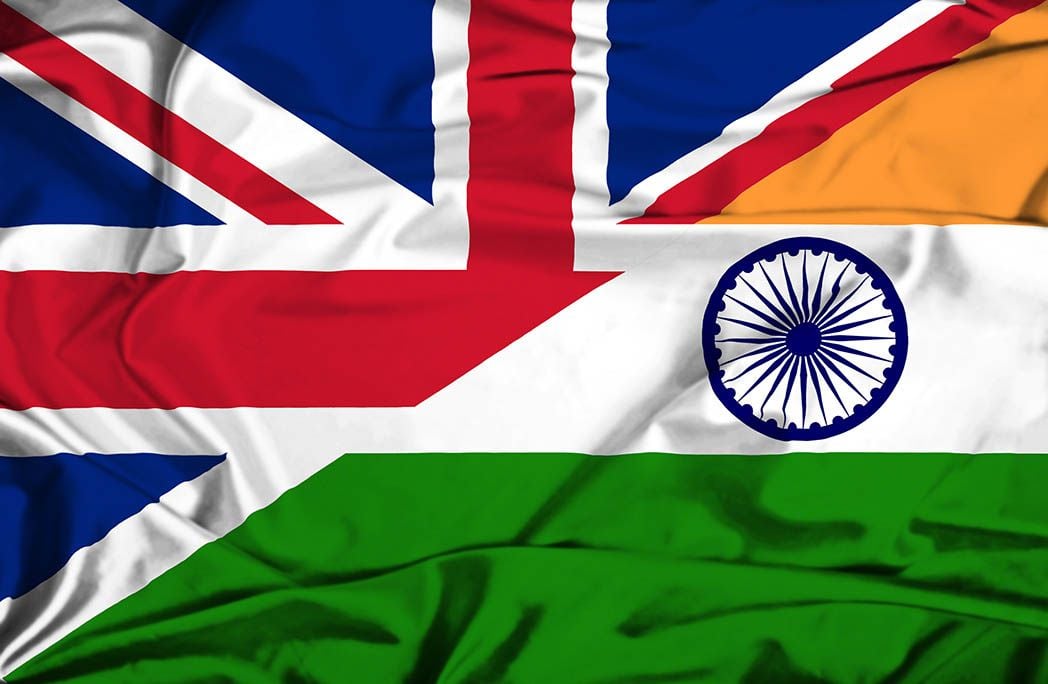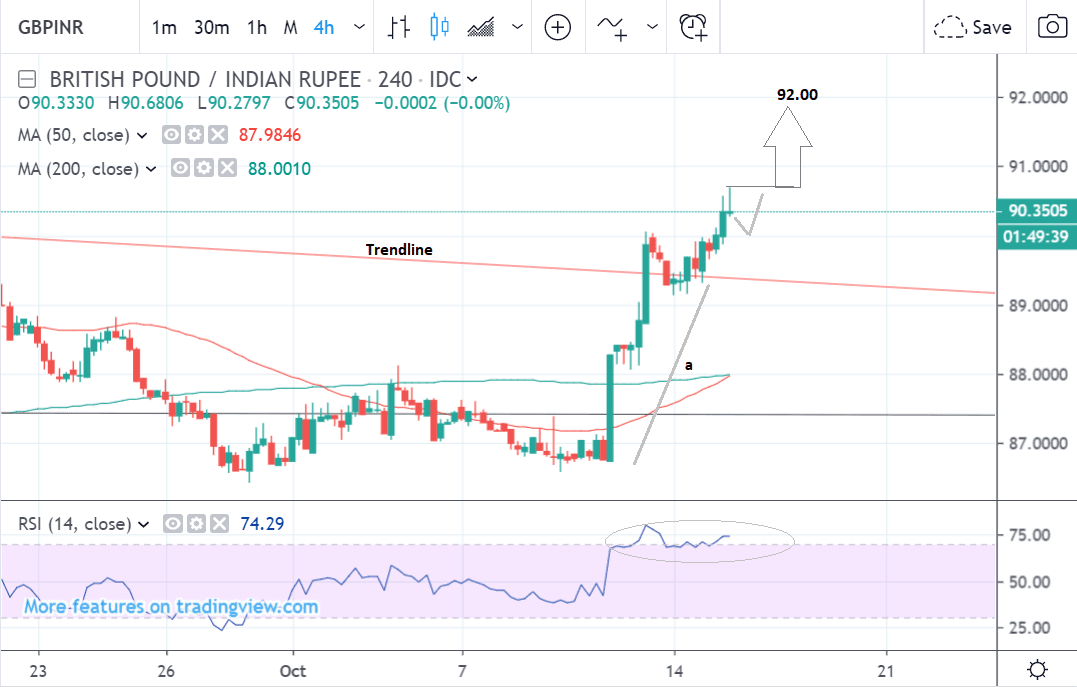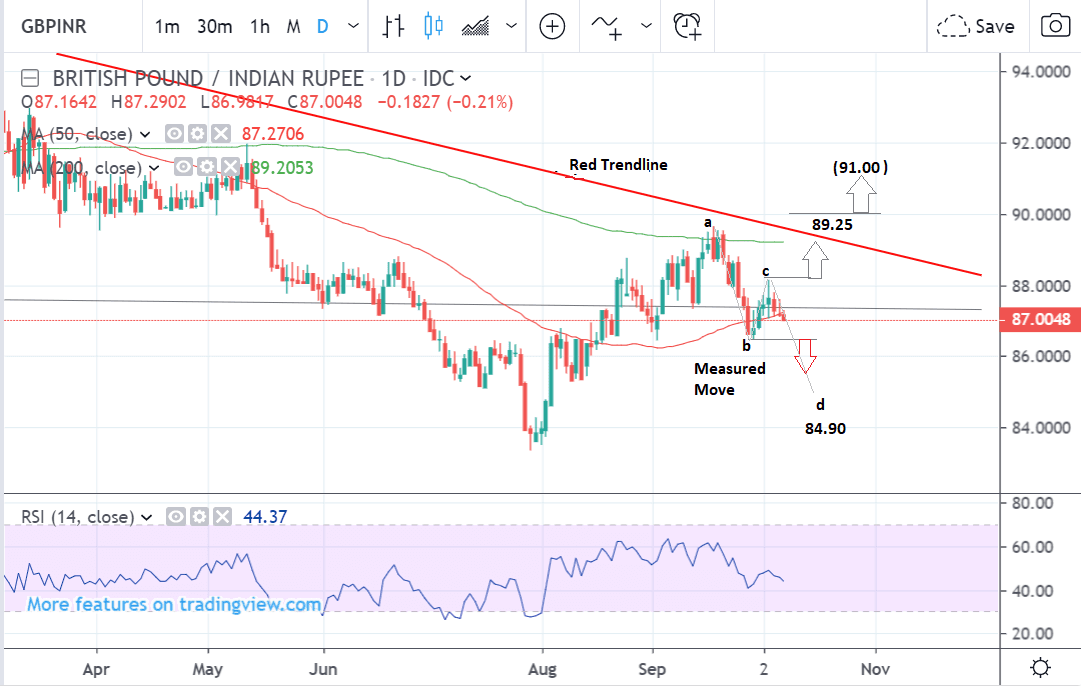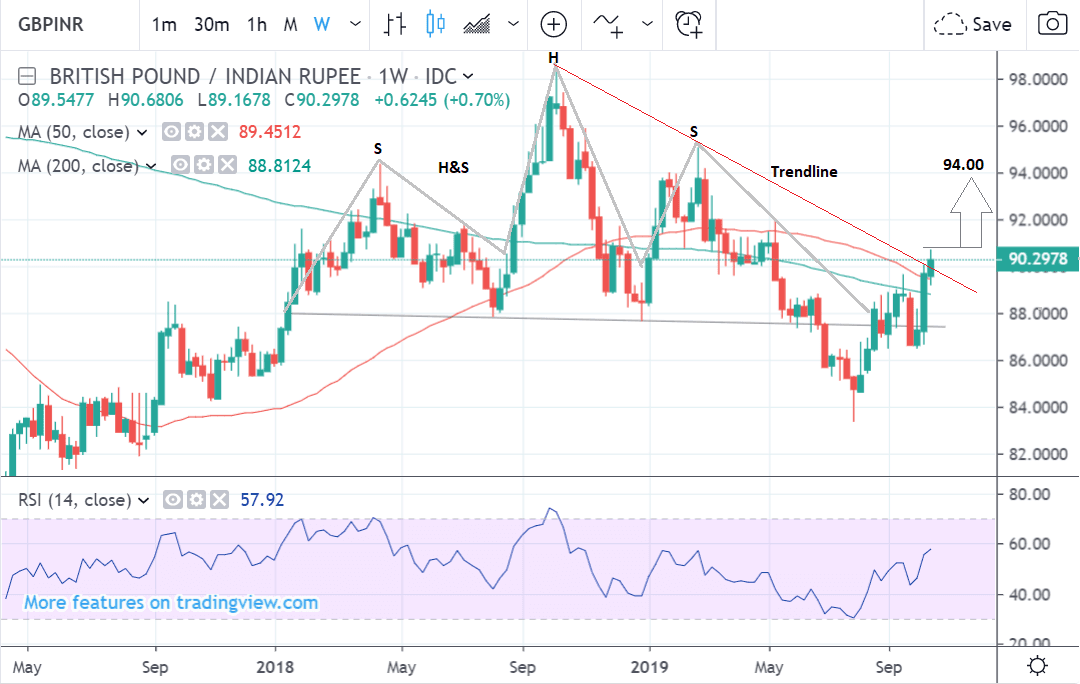Pound-Rupee Rate Breaks Above Key Trendline, Opens Door to Further Upside

Image © Adobe Images
- GBP/INR breaks above key trendline
- Bias is not bullish and suggests further gains
- Rupee to me moved by trade deal and Brexit dynamics
The Pound-to-Rupee exchange rate is trading at around 90.35 at the time of writing, up 0.70% this week so far, and building on the very strong 2.7% rally of the week before.
And further gains are possible with charts now showing the pair in a bullish position after breaking and closing above a long-term make-or-break trendline.
The 4hr chart - used to determine the short-term outlook, which includes the coming week or next 5 days - shows the pair having broken clearly above the red trendline which distinguishes a bearish from a bullish outlook.
Since the break there is now a stronger chance of a continuation higher and a break above the day’s highs at 90.68 would provide confirmation of a continuation up to a target at 92.00.
The RSI momentum indicator is now in the overbought zone above 70, however, so there is also a risk that the market may pull-back before potentially continuing higher. There is a reasonable chance that if it does it will fall back down to support at around 90.00 before resuming its uptrend.
The 92.00 target comes from the length of the move prior to the trendline break labelled ‘a’ on the chart. Technical analysts say breakouts normally reach the same distance as the move immediately prior to them.
The daily chart shows the whole rally since the July 30 lows and the key break above the red make-or-break trendline.
The initial target for the move is at 92.00 and after that there is an increased risk of a pull-back down as bullish traders take profit.
The break above the red trendline is such a game-changer for the pair, however, that the pair will probably continue rising even after the pull-back down, perhaps, to a subsequent target at 93.00.
The daily chart is used to give us an indication of the outlook for the medium-term, defined as the next week to a month ahead.
The weekly chart shows the large bearish head and shoulders reversal pattern at the highs which has dominated the GBP/INR technical outlook for months.
The recent break above the red trendline now negates the H&S and suggests a bullish bias to the longer-term outlook, to perhaps an upside target of 94.00 in the long-term.
The weekly chart is used to give us an indication of the outlook for the long-term, defined as the next few months.
Time to move your money? Get 3-5% more currency than your bank would offer by using the services of foreign exchange specialists at RationalFX. A specialist broker can deliver you an exchange rate closer to the real market rate, thereby saving you substantial quantities of currency. Find out more here.
* Advertisement
The Indian Rupee: What to Watch
The Rupees main drivers in the near term are likely to be the outlook for global growth and investor risk appetite.
The Rupee would have gained support from a positive end to the previous week after the U.S. and China agreed ‘phase 1’ of a trade deal and the UK and EU came close to bridging the gap over Brexit.
Since then some of the initial euphoria has died down after it emerged that the contract for the deal would take 3-5 weeks to prepare and doubts still remained over whether China and the U.S. would both actually sign in the end.
Likewise, with Brexit talks, the start of the week has market a come-down from the optimism of the previous week.
Although both sides said progress had been made, a firm deal is still not on the table and time is running out before the mechanisms start to activate to prevent a ‘no-deal’ on October 31 (the Benn Act) and seek an even longer extension.
Michel Barnier, the EU’s chief negotiator, poured cold water on hopes of an easy win today (Tuesday) when he was reported as saying that the UK’s proposals are still not enough.
At the same time markets are not yet outright pessimistic and there remains a good chance of a deal both for U.S.-China trade and Brexit. Such an outcome would support the Rupee albeit versus the U.S. Dollar and safe-havens since the Pound would also skyrocket on news of a Brexit deal.
The next major release for global risk trends is Chinese Q3 GDP which is forecast to show a slowdown in growth to 6.1% when data is released at 3.00 BST on Friday.
A deeper contraction would sour the outlook for global growth and hit the Rupee as well as other EM currencies; alternatively, a better-than-expected result would support the Rupee and other emerging market currencies.
Judging from trade and inflation data the outlook does not particularly favour a bullish surprise in GDP. This showed a bigger China trade surplus in September - which on the face of it is positive - if it were not for gross trade actually falling.
CPI overshot expectations and hit 3.0% which is the People’s Bank of China target, and this again, on the face of it was positive, however, the details showed the rise in inflation was almost entirely due to a rise in pork prices - a Chinese dietary stable - due to shortages, and not as a result of increased general demand from greater prosperity.
Indian inflation data for September showed a higher-than-expected 3.99% rise on Monday. This was both an increase from the 3.28% previous result and above the 3.70% forecast.
Most of the gains came as a result of food inflation with vegetables showing a 15.4% rise year-on-year.
Manufactured goods, meanwhile, actually showed a -0.42% fall in the same period, reflecting the global economic slowdown in manufacturing.
This could put the Reserve Bank of India (RBI) in a difficult situation with consequences for the Rupee.
On the one hand economists now think the RBI could stop cutting interest rates since inflation is so high, whilst on the other, the data is heavily sector-specific.
Overall, however, the consensus appears to be that the RBI may pause and not cut rates any further at its next meeting, which would be positive for the Rupee.
“Monetary policy has to be cautious and while it had decidedly targeted growth in the earlier policies, it has to consider CPI inflation over which rates have no control," says Madan Sabnavis, chief economist at Care Ratings in relation to the Indian inflation data.
Time to move your money? Get 3-5% more currency than your bank would offer by using the services of foreign exchange specialists at RationalFX. A specialist broker can deliver you an exchange rate closer to the real market rate, thereby saving you substantial quantities of currency. Find out more here.
* Advertisement



